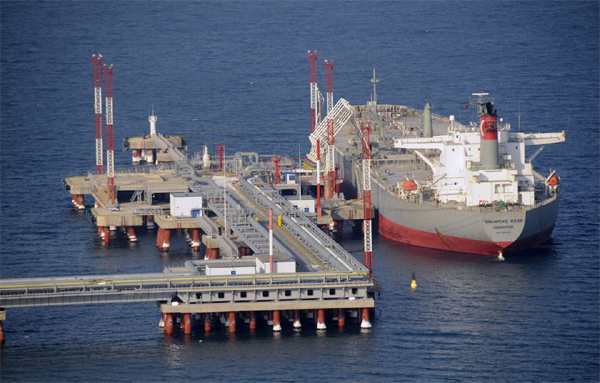
By Julian Lee
Russia can increase domestic energy consumption and boost exports to new markets after some “unfriendly” countries have rejected Russian oil. So says President Vladimir Putin. It sounds simple, but it’s going to be a lot tougher in practice once the next wave of restrictions on Moscow’s oil trade kicks in.
So far, there has been little obvious impact on the volume of crude flowing from Russia’s export terminals. While seaborne shipments drifted lower during the first weeks after Russia’s invasion of Ukraine, there was no sudden collapse. And the rate of exports surged in the first week of April, due in part to the easing of storms in the Black Sea, which had led to a backlog of ships waiting to load at a key port.
What has changed, though, is where a lot of those ships are going. There has been a big jump in the number of cargoes heading for Asia from ports in the Black Sea, the Baltic and even, in one case, from the Arctic port of Murmansk. Flows of crude to Asian countries from Russia’s western ports have surged from zero in the weeks prior to the invasion to 875,000 barrels a day in the first full week of April. That’s almost as much as Russia’s combined daily shipments to Germany, France, Greece, Italy and the U.K. before the invasion.

While Russian oil companies had to offer steep discounts of more than $30 a barrel to sell crude into Europe, they weren’t offering the same price cuts to buyers in India. That’s likely to change, though, as state-run oil refiners switch to privately negotiated deals in the hunt for better terms, instead of buying through public tenders.
But there’s likely to be a limit to how much India’s refiners will buy from Russia. Increased imports of Russian crude will displace purchases from elsewhere and buyers will likely be wary of damaging relations with their traditional suppliers in the Middle East. That may put a cap on the volume they are prepared to take from Russia.
There is also a question of the chemical make-up of the crude. Every crude oil is different and refineries operate most profitably when they process a specific grade of crude, or blend of grades. Increased volumes of Russian crude would have to displace crudes of similar quality, in terms of their gravity and sulfur content, which may also limit the volumes refiners are able to take.

Increased crude flows from ports in western Russia to India and China, perhaps offset by higher flows of Persian Gulf crude to Europe, is also going to put a strain on tanker markets. The greater distances involved will tie up more vessels for longer periods on each delivery. It takes three times as long to carry a cargo of crude from the Russian port of Novorossiysk on the Black Sea to Sikka in India as it does to deliver it to Trieste in Italy.
From the Baltic, which has become Russia’s primary outlet for westbound shipments, the increase is even bigger. It takes a day or two to deliver crude from Primorsk or Ust-Luga to Finland, Lithuania, or Poland, and about a week to ship it to the Netherlands or Germany. A voyage to the west coast of India takes a month, to the east coast, even longer. Given Russia’s pre-invasion mix of destinations for its Baltic Sea crude exports, a full diversion of flows to India would require five to six times as many ships as are typically used. The increased demand will push up prices — good news for ship owners, but bad news for whoever is going to have to absorb the transport costs.
The increase is similar for shipments from Russia’s Arctic port of Murmansk. Most cargoes make a week-long voyage to Rotterdam. One is now on a month-long journey to Paradip on the east coast of India. More may be forced to follow, as the EU begins to toughen up its stance on Russian oil imports.
Where else might Russia sell its crude?
One possibility is into China’s strategic stockpile, if it is willing to offer discounts big enough to make cargoes attractive to the country’s price-conscious buyers. There have even been suggestions that Middle Eastern oil producers might buy cheap Russian crude for processing in their overseas joint venture refineries, freeing up more of their own barrels for export. Big discounts could make that an attractive proposition; the volumes might be as much as 200,000 barrels a day.
But if Europe is serious about weaning itself off Russian crude, Moscow is going to have to find markets for a lot more than that. About 1.8 million barrels a day of Russian crude was shipped to European ports before the invasion of Ukraine.
Using more within Russia only makes sense if the country has something productive to do with it — that will require boosting industry, which seems unlikely.
Increasing sales to Asian buyers, who show no aversion to buying Russian crude, is a superficially attractive solution. But it’s going to be a lot more costly for Russia than selling to high-paying European buyers on its doorstep.
________________________________________________________
Julian Lee is an oil strategist for Bloomberg First Word. Previously he worked as a senior analyst at the Centre for Global Energy Studies.@JLeeEnergy, Energiesnet.com does not necessarily share these views.
Editor’s Note: This article was originally published by Bloomberg, on April 24, 2022. All comments posted and published on EnergiesNet.com, do not reflect either for or against the opinion expressed in the comment as an endorsement of EnergiesNet.com or Petroleumworld.
Use Notice: This site contains copyrighted material the use of which has not always been specifically authorized by the copyright owner. We are making such material available in our efforts to advance understanding of issues of environmental and humanitarian significance. We believe this constitutes a ‘fair use’ of any such copyrighted material as provided for in section 107 of the US Copyright Law. In accordance with Title 17 U.S.C. Section 107. For more information go to: http://www.law.cornell.edu/uscode/17/107.shtml.
energiesnet.com 04 25 20022









